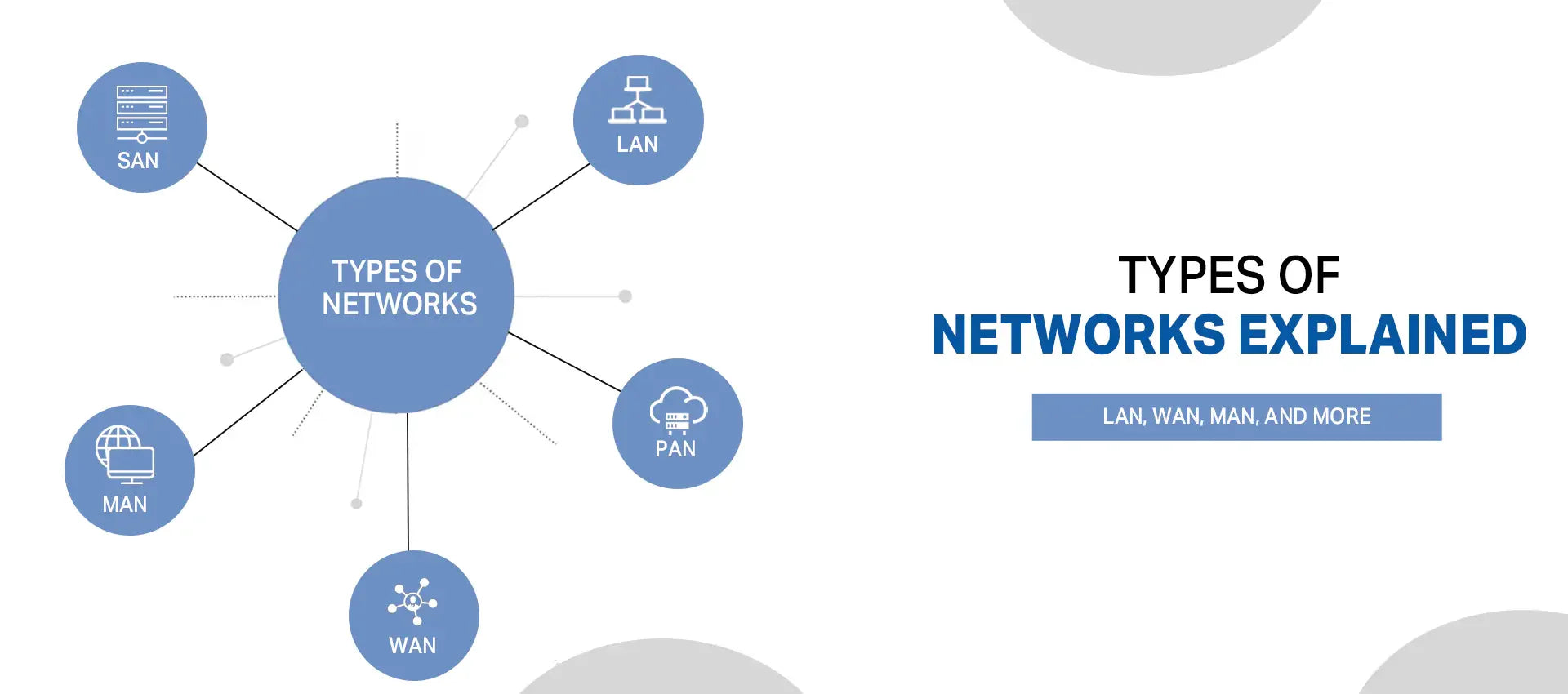Types of Networks Explained: LAN, WAN, MAN, and More

In today’s hyper-connected world, the very backbone of digital communication lies in different kinds of networks. Whether you're streaming a movie at home, conducting a Zoom call at work, or managing a global eCommerce platform, you're relying on one or more specific computer network systems.
Understanding the types of networks isn’t just academic—it’s essential knowledge for IT professionals, system architects, and business leaders who want to build, scale, or secure their infrastructure effectively.
Types of Computer Networks
Let’s unpack the most widely used network type categories—LAN, WAN, MAN, and others—and examine how they differ in scale, design, purpose, and required networking equipment.
Local Area Network (LAN) – Small, Fast, and Everywhere
The Local Area Network (LAN) is the type of networking that people hear about the most. When you access the internet at home, in a cafe, or anywhere in your office, you’re using a LAN. Designed for use in homes, schools, and small offices, LANs are valued for their speed and responsiveness. Core network items network specialists use include Ethernet cables, routers, switches, and wireless access points.
For more advanced control and segmentation, IT teams often use Types of Network Switches, such as managed or stackable switches, within a LAN setup. Examples of high-performance switches for LAN environments include the reliable Netgear ProSafe JGS524 24-Port Gigabit Ethernet Switch.
Wide Area Network (WAN) – The Giant Backbone
Where LANs are local, Wide Area Networks (WANs) go global. A WAN connects multiple LANs across large geographic distances using leased telecommunication lines, satellites, or undersea cables. The Internet itself is the largest WAN in existence. However, enterprises, banks, and government bodies also maintain private WANs to connect regional or international offices. These often employ VPNs and MPLS for secure data transport. Robust switches like the Cisco C9500-40X-A Switch support WAN infrastructure demanding high throughput and scalability.
Metropolitan Area Network (MAN) – The City-Level Middle Ground
MANs fill the gap between LANs and WANs. Designed to cover a city or metropolitan region, they connect multiple LANs within the area—think of university campuses, airport networks, or city-wide surveillance grids.
A MAN typically uses high-speed fiber optic lines and may be managed by a single organization or a consortium. The right types of networking hardware, including high-throughput routers and aggregation switches, are critical to ensure consistent speed across long distances.
Personal Area Network (PAN) – Your Pocket-Sized Network
Even the tiniest area, the Personal Area Network (PAN), allows your smartwatch, Bluetooth headphones, fitness tracker, and smartphone to create small networks around you.
You can join these networks using Bluetooth, NFC, or USB. The device enables flawless communication support between networks only a few meters away. Even though they don’t cover much ground, PANs are critical for IoT and wearable gadgets.
Campus Area Network (CAN) – Connecting Departments Across Grounds
Somewhere between LAN and MAN lies the Campus Area Network (CAN), which connects multiple buildings on a university, business, or hospital campus. It’s optimized for internal communication and supports wired and wireless traffic.
Unlike MANs, which may involve service providers, CANs are usually managed by a single organization and built with extensive networking equipment, including routers, Types of Network Switches, and firewalls. Switches such as the Cisco WS-C4506-E Switch Chassis play a key role in large CAN deployments.
Storage Area Network (SAN) – For Data Storage Systems
SANs aren’t about user connectivity—they're specialized types of computer network systems designed to connect storage devices to servers. These networks bypass standard LAN traffic, creating high-speed connections between storage pools and computing nodes.
SANs are vital in data centers, enterprise IT, and cloud environments. They rely on Fiber Channel switches, HBAs, and specialized software to deliver low-latency performance. The Juniper EX3400-48P Front-to-Back Airflow Switch is an example of a high-performance switch used in SANs, offering efficient airflow and reliability.
Factors That Distinguish Types of Networking
So what truly differentiates one network type from another? A few key characteristics:
|
Factor |
LAN |
WAN |
MAN |
PAN |
SAN |
CAN |
|
Coverage Area |
Room/Building |
Country/World |
City |
Person |
Data Center |
Campus |
|
Speed |
High |
Moderate |
High |
Low to Moderate |
Very High |
High |
|
Ownership |
Private |
Mixed (ISP/Gov) |
Often Public |
Personal |
Enterprise |
Organization |
|
Complexity |
Low |
High |
Medium |
Very Low |
High |
Medium |
|
Use Case |
Office/Home |
Inter-office comms |
City-wide service |
IoT/Wearables |
Storage Systems |
Universities, Enterprises |
Different needs, different scopes—each type of networking setup is tailor-made for a specific use case.
Common Networking Equipment Across Networks
Regardless of size, every network relies on reliable hardware. Some essentials include:
- Routers – direct data between networks
- Switches – manage device-level connections (examples: Cisco WS-C6509-E, Juniper EX3400-48P)
- Access Points – extend wireless coverage
- Firewalls – guard against intrusions
- Cables & Transceivers – provide the backbone of wired setups
Choosing the right networking equipment depends on the scale and nature of your network type.

